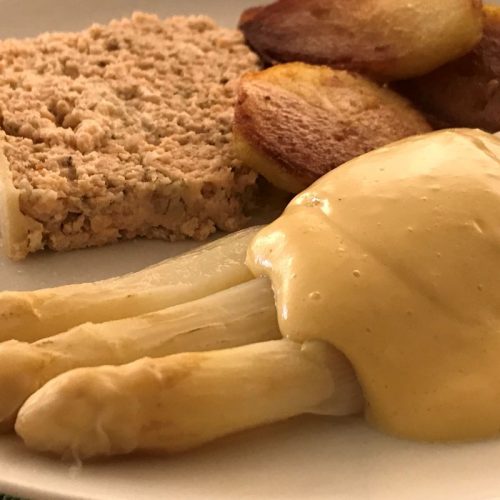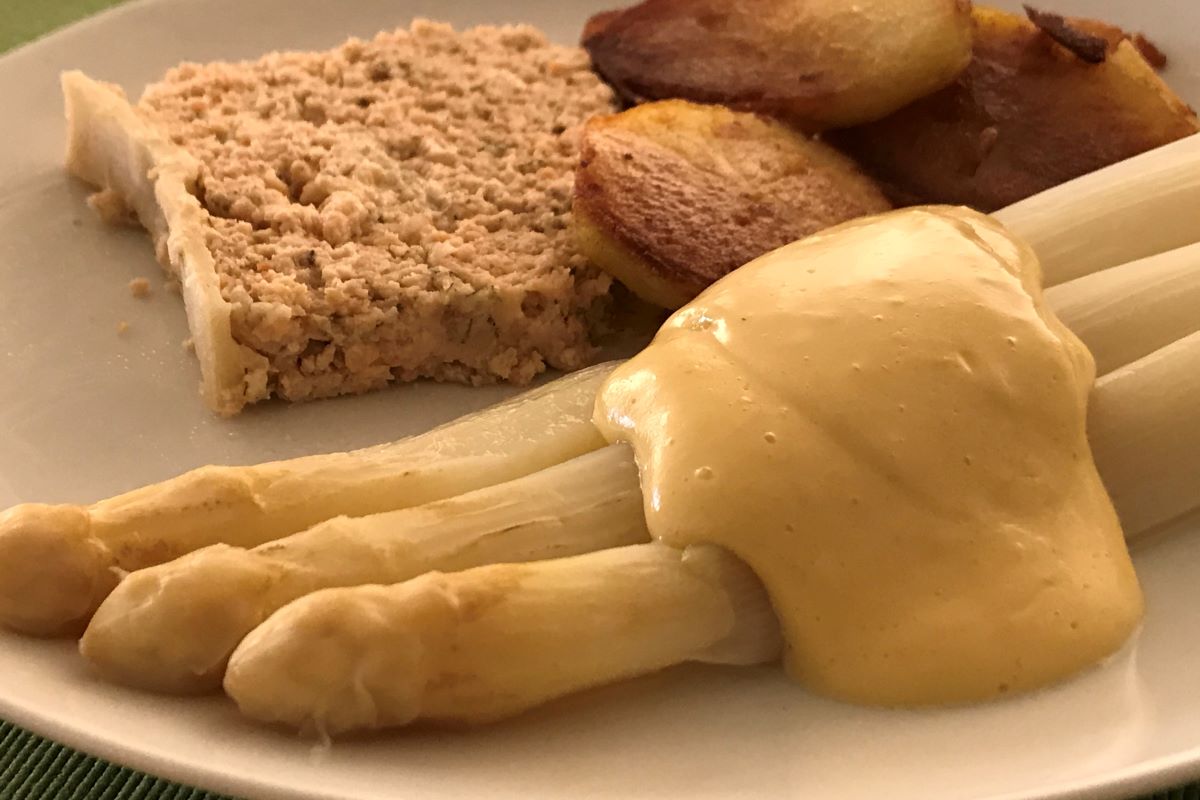Béarnaise sauce (original) is an egg-clarified butter sauce, which is rich in butterfat. It only differs from hollandaise sauce by the use of tarragon and vinegar instead of lemon juice in the gastrique. Béarnaise sauce goes very well with steak, with salmon and with vegetables such as asparagus. However, the richness of the butterfat does put some people off. Even so if butter by itself is not per se unhealthy. Therefore we make the sauce with half the total fat and only 10% of the butter fat the original recipe is asking for. The other 40% we replace by a more heart healthy fat such as safflower oil, sunflower oil or rape seed oil. These are all neutral tasting vegetable oils. And if you want to replace all of the butterfat, that is possible too within this same recipe.
The art of making béarnaise sauce
Béarnaise sauce as cooks learn to make it consists of around 70% butterfat by weight. First a gastrique is made from shallot, crushed pepper, tarragon, white wine and vinegar where the mixture is reduced by half on medium fire. Then, after cooling down the gastrique, it is mixed with egg yolks and this mixture is heated while whisking au bain marie. To the resulting thick foamy sauce we add the molten butterfat slowly under vigorous whisking. In essence a kind of sabayon is created in situ au bain marie, which has a great ability to disperse liquid fat.
When the sauce cools down, the butter fat droplets become solid and this may result in a sauce that becomes inhomogeneous. Also the organoleptic properties of the sauce will change then for the worse. Therefore a full butter fat sauce requires to be served warm and in a colder environment may already have separated at the end of a dinner.
Here we reduce the amount of total fat in the recipe and optionally replace much or all of the butterfat by a neutral tasting vegetable oil. As the taste of the gastrique and the homogeneity of the sauce determine largely the taste and organoleptic properties of the sauce, you will find the taste of the sauce made this way hardly -if any- inferior to the original! The sauce also keeps more stable when cooling down. The sauce can be stored overnight in a fridge and re-heated au bain marie the next day. This is because the liquid vegetable oil will mix with the butter fat and reduce the melting point of the oil phase.
Special equipment
- double boiler for au bain marie cooking
- whisk

Béarnaise sauce with a heart healthy streak
Ingredients
Ingredients to make the gastrique
- 1/4 cup white wine vinegar
- 1/2 cup white wine
- 1/2 tbsp olive oil
- 2 tbsp tarragon
- 1 small shallot
- 1 tsp sea salt or kosher salt
- 1/4 tsp ground pepper
Ingredients for the oil phase
- 0.7 oz (20 g) butter fat
- 2.8 oz (80 g) sunflower oil
Other ingredients
- 4 egg yolks (total 2.4 oz or 70 g)
Instructions
Instructions to make the gastrique
- Dice the shallot.
- Heat the olive oil in a small pan and glaze the shallot at medium fire for 5 minutes.
- Add the vinegar, the wine, the tarragon and add the salt and pepper
- Let simmer for 15 minutes with the lid on (low heat) and then increase the fire a bit and take the lid off to let the vinegar and alcohol cook off a little. Aim to keep 3.5 oz (100 g) liquid left
- Strain through a small sieve and press with a spoon the shallot/tarragon mixture in the sieve to release all its juices. Let the gastrique cool to room temperature and reserve
Instructions to make the oil phase
- Melt the ghee and heat the sunflower oil to approximately 120 F (50 C) (a brief time in the microwave oven works) and mix together
Instructions to bring the sauce together
- Bring egg yolks and gastrique to room temperature. Thereafter mix them in a stainless steel bowl with a whisk
- Heat the bowl au bain marie under constant whisking. After a few minutes the temperature will approach 163 F (73 C) and the mixture will become thicker and more viscous. Continue whisking for a few tens of seconds, to whisk a lot of air in, but be careful not to over-heat.
- Take the mixture off the heat source and place on a towel or something that insulates.
- Under vigorous whisking start adding the oil, first drop wise, then in larger speed
- The sauce becomes even thicker. Serve immediately
Notes
Remarks
- Safflower oil is very high in linoleic acid, a poly-unsaturated fat. But it is more costly too than sunflower or rapeseed oil. In all cases, try to obtain first pressed oils and keep them in the fridge. Store them dark and firmly closed to prevent oxidation. The more poly-unsaturated oils, the more tendency to become rancid. Air, light, and higher temperatures promote this oxidation process.
- Many recipes for making the gastrique do not glaze the shallot first in oil. I believe the glazing improves taste. But more so a little olive or other vegetable oil does help to make a pre-emulsion. As by mixing the gastrique with the egg yolks this pre-emulsion forms. Then the in-situ sabayon is made when heating and whisking the mixture au bain marie. It increases the success rate of making a stable and homogeneous sauce.



